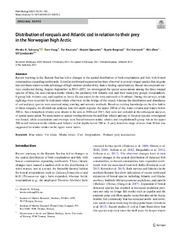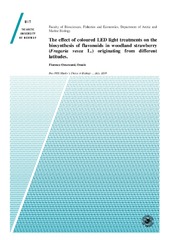Institutt for arktisk og marin biologi: Nye registreringer
Viser treff 861-880 av 2086
-
Distribution of rorquals and Atlantic cod in relation to their prey in the Norwegian high Arctic
(Journal article; Tidsskriftartikkel; Peer reviewed, 2021-03-14)Recent warming in the Barents Sea has led to changes in the spatial distribution of both zooplankton and fish, with boreal communities expanding northwards. A similar northward expansion has been observed in several rorqual species that migrate into northern waters to take advantage of high summer productivity, hence feeding opportunities. Based on ecosystem surveys conducted during August–September ... -
The Future of DNA Barcoding: Reflections from Early Career Researchers
(Journal article; Tidsskriftartikkel; Peer reviewed, 2021-07-09)Over the last two decades, the use of DNA barcodes has transformed our ability to identify and assess life on our planet. Both strengths and weaknesses of the method have been exemplified through thousands of peer-reviewed scientific articles. Given the novel sequencing approaches, currently capable of generating millions of reads at low cost, we reflect on the questions: What will the future bring ... -
Determinants of heart rate in Svalbard reindeer reveal mechanisms of seasonal energy management
(Journal article; Tidsskriftartikkel; Peer reviewed, 2021-06-28)Seasonal energetic challenges may constrain an animal's ability to respond to changing individual and environmental conditions. Here, we investigated variation in heart rate, a well-established proxy for metabolic rate, in Svalbard reindeer (Rangifer tarandus platyrhynchus), a species with strong seasonal changes in foraging and metabolic activity. In 19 adult females, we recorded heart rate, ... -
Experimental warming differentially affects vegetative and reproductive phenology of tundra plants
(Journal article; Tidsskriftartikkel; Peer reviewed, 2021-06-11)Rapid climate warming is altering Arctic and alpine tundra ecosystem structure and function, including shifts in plant phenology. While the advancement of green up and flowering are well-documented, it remains unclear whether all phenophases, particularly those later in the season, will shift in unison or respond divergently to warming. Here, we present the largest synthesis to our knowledge of ... -
Combined effects of crude oil exposure and warming on eggs and larvae of an arctic forage fish
(Journal article; Tidsskriftartikkel; Peer reviewed, 2021-04-16)Climate change, along with environmental pollution, can act synergistically on an organism to amplify adverse effects of exposure. The Arctic is undergoing profound climatic change and an increase in human activity, resulting in a heightened risk of accidental oil spills. Embryos and larvae of polar cod (Boreogadus saida), a key Arctic forage fish species, were exposed to low levels of crude oil ... -
Trace element concentration and stable isotope ratio analysis in blueberries and bilberries: A tool for quality and authenticity control
(Journal article; Tidsskriftartikkel; Peer reviewed, 2021-03-09)Vaccinium genus berries—wild bilberries (Vaccinium myrtillus L.) and cultivated highbush blueberries (Vaccinium corymbosum L.)—are consumed worldwide, and their consumption has a trend of stable increase. Thus, considering their wide use in ethnomedicine, for juice and jam production, as functional food, as well as their use in preparations of extracts which have application potential in pharmaceutical ... -
Future trajectories of change for an Arctic deep-sea ecosystem connected to coastal kelp forests
(Journal article; Tidsskriftartikkel; Peer reviewed, 2020-11-22)Environmental stressors related to climate change and other anthropogenic activities are impacting Arctic marine ecosystems at exceptional rates. Within this context, predicting future scenarios of deep-sea ecosystems and their consequences linked with the fate of coastal areas is a growing need and challenge. We used an existing food-web model developed to represent the outer basin of the Malangen ... -
Northern Fennoscandia via the British Isles: evidence for a novel postglacial recolonization route by winter moth (Operophtera brumata)
(Journal article; Tidsskriftartikkel; Peer reviewed, 2021)The frequency and severity of outbreaks by pestiferous insects is increasing globally, likely as a result of human-mediated introductions of non-native organisms. However, it is not always apparent whether an outbreak is the result of a recent introduction of an evolutionarily naïve population, or of recent disturbance acting on an existing population that arrived previously during natural range ... -
Functional Pattern of Benthic Epifauna in the Chukchi Borderland, Arctic Deep Sea
(Journal article; Tidsskriftartikkel; Peer reviewed, 2021-05-26)Assessment of Arctic deep-sea ecosystem functioning is currently an urgent task considering that ongoing sea-ice reduction opens opportunities for resource exploitation of yet understudied deep-sea regions. We used Biological Trait Analysis to evaluate ecosystem functioning and test if common paradigms for deep-sea fauna apply to benthic epifauna of the deep-sea Arctic Chukchi Borderland (CBL). We ... -
Comparative Modeling of Cod-Capelin Dynamics in the Newfoundland-Labrador Shelves and Barents Sea Ecosystems
(Journal article; Tidsskriftartikkel; Peer reviewed, 2021-03-09)The Atlantic cod (Gadus morhua) stocks in the Newfoundland-Labrador Shelves (NL) and Barents Sea (BS) ecosystems have shown divergent trajectories over the last 40 years. Both stocks experienced either an important decline (BS) or a collapse (NL) in the mid-1980s and early 1990s, respectively. After these population reductions, the BS stock quickly rebounded and it is currently at record high levels, ... -
Blue justice: A survey for eliciting perceptions of environmental justice among coastal planners’ and small-scale fishers in Northern-Norway
(Journal article; Tidsskriftartikkel; Peer reviewed, 2021-05-13)Ocean-based economic development arising from an increasing interest in the ‘blue economy’ is placing ecosystems and small-scale fisheries under pressure. The dominant policy response for dealing with multiple uses is the allocation of coastal space through coastal zone planning (CZP). Recent studies have shown that the rush to develop the blue economy and regulate coastal activity can result in ... -
Niche construction mediates climate effects on recovery of tundra heathlands after extreme event
(Journal article; Tidsskriftartikkel; Peer reviewed, 2021-02-04)Climate change is expected to increase the frequency and intensity of extreme events in northern ecosystems. The outcome of these events across the landscape, might be mediated by species effects, such as niche construction, with likely consequences on vegetation resilience. To test this hypothesis, we simulated an extreme event by removing aboveground vegetation in tundra heathlands dominated by ... -
Hypoxia Routes Tryptophan Homeostasis Towards Increased Tryptamine Production
(Journal article; Tidsskriftartikkel; Peer reviewed, 2021-02-19)The liver is the central hub for processing and maintaining homeostatic levels of dietary nutrients especially essential amino acids such as tryptophan (Trp). Trp is required not only to sustain protein synthesis but also as a precursor for the production of NAD, neurotransmitters and immunosuppressive metabolites. In light of these roles of Trp and its metabolic products, maintaining homeostatic ... -
Case report: Subclinical verminous pneumonia and high ambient temperatures had severe impact on the anesthesia of semi-domesticated Eurasian tundra reindeer (Rangifer tarandus tarandus) with medetomidine-ketamine
(Journal article; Tidsskriftartikkel; Peer reviewed, 2021-02-24)Semidomesticated Eurasian tundra reindeer (<i>Rangifer tarandus tarandus, n</i> = 21) were scheduled twice for chemical immobilization with medetomidine–ketamine as part of a scientific experiment in June 2014. During the first round of immobilizations, seven animals developed severe respiratory depression (RD). Three individuals died, and 4 recovered. The ambient temperature during the 2 days of ... -
The enigma of interspecific plasmodesmata: insight from parasitic plants
(Journal article; Tidsskriftartikkel; Peer reviewed, 2021-04-01)Parasitic plants live in intimate physical connection with other plants serving as their hosts. These host plants provide the inorganic and organic compounds that the parasites need for their propagation. The uptake of the macromolecular compounds happens through symplasmic connections in the form of plasmodesmata. In contrast to regular plasmodesmata, which connect genetically identical cells of ... -
The effect of coloured LED light treatments on the biosynthesis of flavonoids in woodland strawberry (Fragaria vesca L.) originating from different latitudes
(Master thesis; Mastergradsoppgave, 2019-07-31)Flavonoids are a group of phenolic compounds produced in plants. They have many biological functions in plants and also beneficial bioactivities in human’s health. Light quality is one of the major environmental factors regulating the accumulation of flavonoids in plants. Understanding plants accumulation of secondary metabolites in response to light qualities is important in order to optimize plants ... -
Carbon export in the seasonal sea ice zone north of Svalbard from winter to late summer
(Journal article; Tidsskriftartikkel; Peer reviewed, 2021-01-21)Phytoplankton blooms in the Arctic Ocean's seasonal sea ice zone are expected to start earlier and occur further north with retreating and thinning sea ice cover. The current study is the first compilation of phytoplankton bloom development and fate in the seasonally variable sea ice zone north of Svalbard from winter to late summer, using short-term sediment trap deployments. Clear seasonal patterns ... -
G3BPs tether the TSC complex to lysosomes and suppress mTORC1 signaling
(Journal article; Tidsskriftartikkel; Peer reviewed, 2021-01-25)Ras GTPase-activating protein-binding proteins 1 and 2 (G3BP1 and G3BP2, respectively) are widely recognized as core components of stress granules (SGs). We report that G3BPs reside at the cytoplasmic surface of lysosomes. They act in a non-redundant manner to anchor the tuberous sclerosis complex (TSC) protein complex to lysosomes and suppress activation of the metabolic master regulator mechanistic ... -
Lifelong divergence of growth patterns in Arctic charr life history strategies: implications for sustainable fisheries in a changing climate
(Journal article; Tidsskriftartikkel; Peer reviewed, 2021-01-18)Arctic charr (<i>Salvelinus alpinus</i> Linnaeus, 1758) are phenotypically variable with multiple life history strategies including anadromous and freshwater resident individuals. The mechanism determining life history is believed to be set early in life. Anadromous individuals show greater seasonality in growth and feeding after the first seaward migration relative to resident conspecifics. We used ... -
Optimization of a low flow sampler for improved assessment of gas and particle bound exposure to chlorinated paraffins
(Journal article; Tidsskriftartikkel; Peer reviewed, 2021-02-23)An optimized low volume sampler was developed to determine both gas- and particle bound concentrations of short and medium-chain chlorinated paraffins (S/MCCPs). Background contamination was limited by the sampler design, providing method quantification limits (MQLs) at least two orders of magnitude lower than other studies within the gas (MQL: 500 pg (ΣSCCPs), 1.86 ng (ΣMCCPs)) and particle (MQL: ...


 English
English norsk
norsk


















